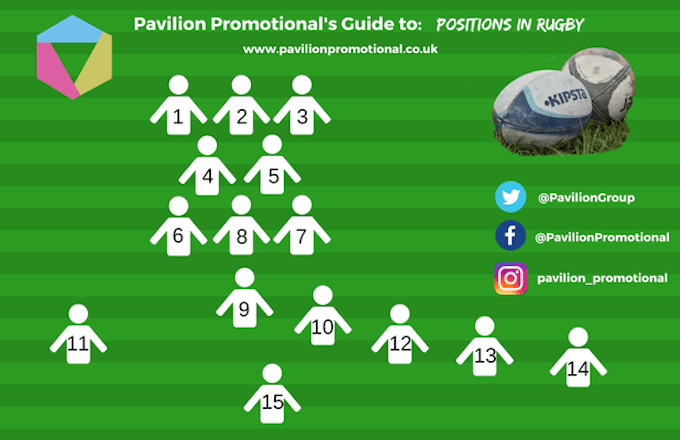The Positions
So let's start woth the plying positions in Rugby
There are 15 players on each side during a game of rugby, and unlike football teams, you will see that each player’s shirt number actually identifies their position on the field. You’ll see that each player that walks out will always have shirt numbers 1-15. Here is the formation of a rugby side.
Numbers one to eight dictate the forwards and numbers nine to fifteen are the backs. Here is the run down of the positions for each number.
1: Left Prop
2: Hooker
3: Right Prop
4: Second Row
5: Second Row
6: Left Flanker
7: Right Flanker
8: Number 8
9: Scrum Half
10: Fly Half
11: Winger
12: Inside Centre
13: Outside Centre
14: Winger
15: Full Back
The forwards are the big tacklers, and are also the ones that makes up the scrum. The scrum half is the player that puts the ball in the scrum, and is generally known as the primary passer, being one you’ll see more than often behind the ruck. The fly half is usually the kicker, whether they are punts, conversions or penalties. The wingers are generally the fastest on the field, and the full back is not only a fast and agile player, but is also a big tackler, being the last line of defence.

The Game
The way to win the game is to score as many points as possible. The way to get the most points in a play is by scoring a try. Whilst in American football you can just run over the line to score, in rugby you need to place the ball onto the ground beyond the try line. Once you have scored a try, your kicker can have an attempt at scoring a conversion. The importance of where you score a try is very important, as the conversion is taken along the same perpendicular line that you score the try. For instance, if you score close to the touch line (side line) then you will see the ball being kicked along the same touch line. If you score under the posts, the ball can be kicked from however far out, but directly in front of the posts. This is the main reason why you see the scorers running into the scoring zone, then running sideways to get the ball as central as possible.
Points are awarded in this way: A try counts as five points, and then the kicker is automatically awarded a conversion attempt, which is worth two points. If the kicker tries for a drop goal in the middle of the play, that is worth three points. If a kicker scores from a penalty kick, then the team is given three points.
The match is played for eighty minutes, made up of two forty-minute halves. The play is non-stop, pausing only for injuries, substitutions, penalties etc.
Gameplay
Whilst the main aim of the game is to score tries, the difficulty is getting to the end of the pitch. This is made especially difficult by the rule that the ball can only be passed backwards. Any forward pass or knock-on results in something called a scrum.
If the ball is kicked or is run out of the side lines, then a lineout occurs. This is a throw in, where the forwards line up side by side, and the hooker throws it in between the two lines. The players who jump higher can grab the ball and pass back to their own team.
When a player is tackled, he must go down to the ground, and also let go of the ball. They are allowed to place the ball backwards to give their own team a slight advantage, but holding onto the ball results in a penalty.
The offside rule is naturally something very different from the football rule. A rugby player is offside if they interfere with play whilst they are in front of the ball, be that obstructing a player or even picking the ball up.
Some types of fouls:
- Obstructing a player
- Physical violence towards another player (tripping, punching, kicking)
- Tackling a player without the ball. Unlike American Football, you cannot make any contact with another player, even to guard them.
- Tackling a player whilst he is in the air.
“When I first took up rugby, I started at 8, but when I got to about 13 I got quite serious about it, and I phoned my Dad, who was Italian and didn’t really know anything about rugby… and I said ‘Dad, I’m really getting into this game rugby’, so bless him the next time I got home I saw this book on the table and it was the laws of rugby union… and I said to him ‘Dad, it’s a waste of time reading that. I’ve played three games and there don’t appear to be any laws whatsoever’” – Lawrence Dallaglio on Top Gear, 2007
Share this article
Hear Our Latest News and Get Sporting Updates for Your Next Marketing Campaign
Subscribe and be the first to know about our latest ideas and advice on all thing sport merchandise.
Are you thinking of getting some promotional rugby merchandise for your next marketing campaign? From your own bespoke balls to custom Gilbert balls, sports bags and more, we can help you convert your next marketing campaign.